The French press exercise, which is also called the French curl exercise, is a popular weightlifting drill that trains all three heads of the triceps muscles.
Since it’s an overhead movement, the standing French press places your shoulders into flexion and thus gives greater emphasis to the biggest muscle of the triceps, namely, the long head, which is the only tricep head that acts on the shoulder joint.
This guide shows you how to do 8 different French press lifting exercises and then discusses the technique mistakes that you need to avoid for best results.
Related: Barbell tricep workouts
Barbell French press exercise details
- Also Known As: French curl, BB French press
- Main Muscles: Triceps
- Exercise Type: Strength
- Exercise Mechanics: Isolation
- Difficulty Level: Intermediate
- Equipment Needed: Barbell, weights
How to do a French press for your triceps
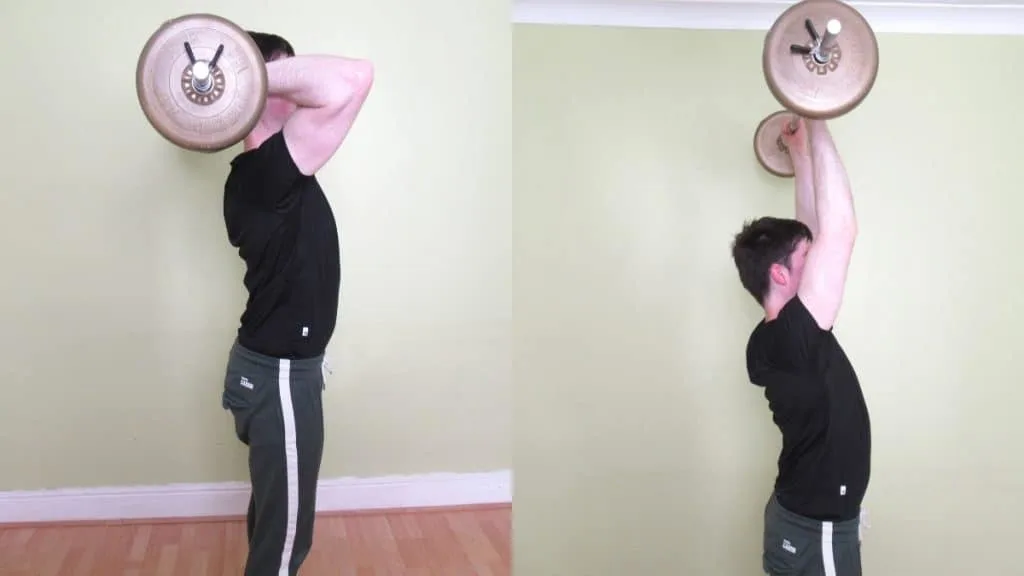
- Load a moderate amount of weight onto a barbell.
- Grab the bar with an overhand grip just inside shoulder-width.
- Stand up straight with your feet hip-width apart and tighten your core.
- Press the bar over your head so that your elbows are locked out.
- Tuck your elbows in slightly so that they’re not flared out too much.
- Lower the bar behind your head by “breaking” at your elbows.
- Descend in a controlled manner until you feel an intense stretch in your triceps (particularly in the inner part).
- Lift the bar back up by flexing your triceps forcefully until your elbows reach full extension.
- Perform 3-5 sets of 8-15 reps in total.
French press exercise variations
In addition to barbell French presses, there are more than 7 other types of French curls that you can do for your triceps. This section explains the pros and cons of each variation so that you can decide which exercise is best for your training ambitions.
Seated French press
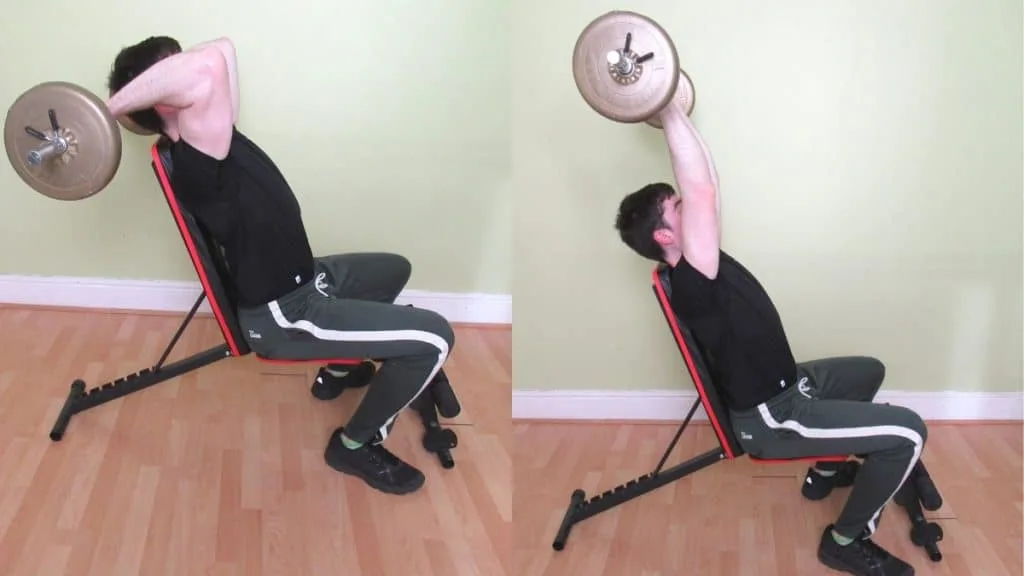
Let’s do a quick but thorough seated vs standing French press comparison to clarify the differences.
The seated French press is identical to the Standing French press in terms of lifting technique; you lower the bar behind your head in a controlled manner until you feel a deep stretch in your triceps; then you lift the weight back up by flexing your triceps until your elbows reach full extension.
The main difference is that the standing French press exercise requires more core strength than the seated version.
This extra abdominal exertion means that the standing barbell French press burns more calories and trains your abs to a greater extent than the seated variation. As such, if you’re training for fat loss and want to give your abs a decent isometric workout in the process, then standing French presses are the way to go. [1]
On the other hand, if you want to maximally isolate your triceps, then the seated version is the better choice. This is because you don’t have to put as much effort into bracing your core when your torso is already stabilized by the backrest of the bench. Instead, you can channel all of your energy into training your triceps, which, after all, is the whole point of this isolation exercise.
Lying French press
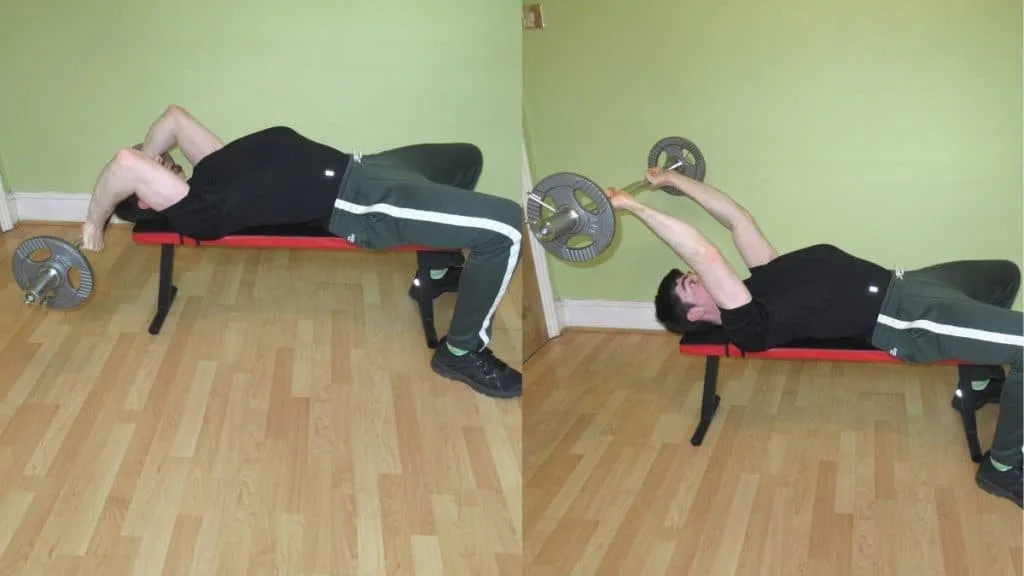
By French press, most people usually mean some kind of overhead French press.
Yet, since the triceps French press is essentially just an elbow extension exercise, there’s no reason why you can’t perform the movement in a lying position.
You want to begin by lying on a flat bench and then pressing the bar over your head. From there, bend your elbows to lower the bar behind your head. Avoid lowering the weight directly to your face or forehead as it can hurt your elbows. Once you feel a strong stretch in your triceps, lift the weight back up by flexing your triceps until your elbows are locked out.
It’s okay to use some shoulder movement during a lying French press because, as mentioned in the intro, the long head of the triceps acts on the shoulder. So for optimal development, it’s actually better to bring the bar behind your head by involving your shoulders in the exercise than it is to lower the bar straight up and down.
Dumbbell French press
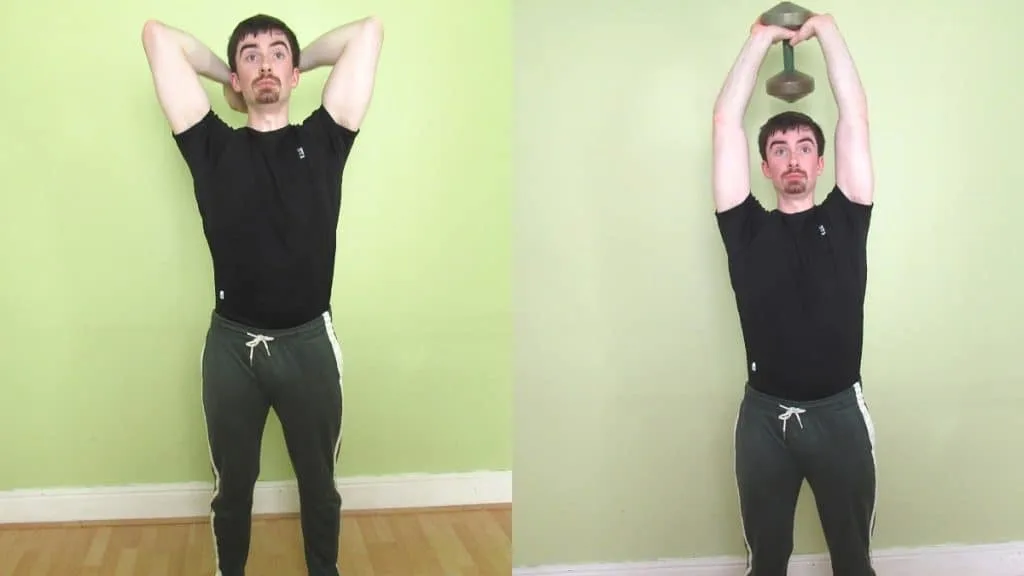
You can’t lift as much weight on the dumbbell French press as you can on the barbell French press because balancing two independent weights is harder than stabilizing one.
The trade-off is that the dumbbell version ensures that both of your triceps are receiving similar amounts of stimulation, which in turn encourages your upper arms to grow in proportion. This symmetry-building benefit is particularly helpful if you already have well-developed triceps and want to enhance their aesthetics by making them more even in terms of size.
If, on the other hand, you’re a beginner, then sticking to barbell French presses is generally the best idea. This is because barbells enable you to overload your triceps with more resistance than dumbbells, which means that the BB French press has better mass-building potential in theory (in practice, the differences are unlikely to be significant if you train consistently).
Additionally, the dumbbell French press places your wrists in a neutral position, which helps to keep the strain off your joints as the weights become heavier. [2]
EZ bar French press
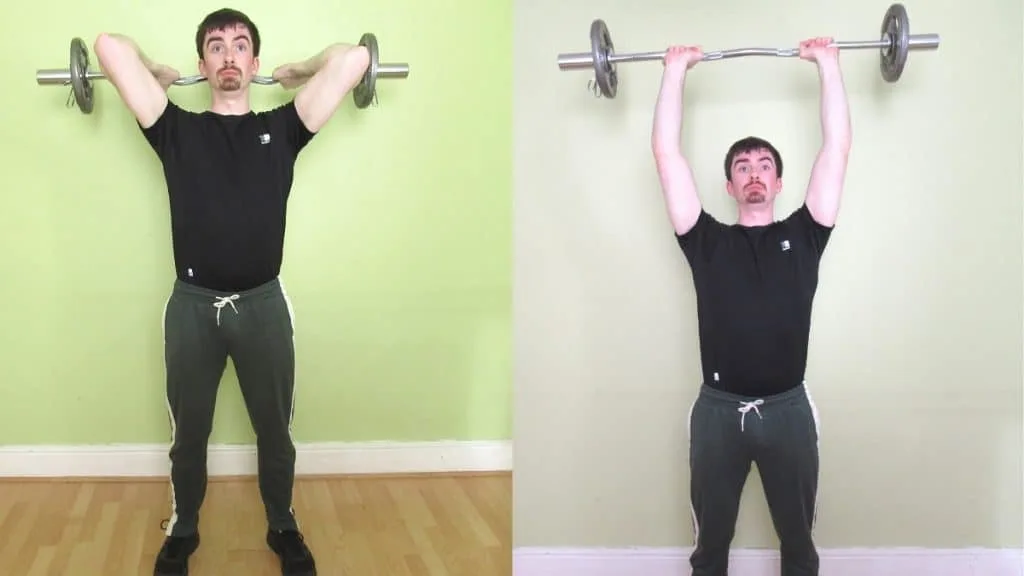
The EZ bar French press is identical to the barbell tricep French press in terms of form; the difference is that the EZ version puts less pressure on your wrists because EZ bars have semi-pronated grips whereas straight bars don’t.
Of course, if you’re a novice lifter who’s not lifting much weight, then you might not feel any wrist discomfort during the straight bar French press. However, as your triceps become stronger and the weights become heavier, you might start to feel more joint strain, which, besides putting your wrist health at risk, can make it difficult to focus on training your triceps.
You can use any kind of cambered bar for the French curl exercise. However, for tracking your strength progress, it’s often best to use a fixed bar that displays the weight on the side so that you know exactly how much resistance you’re lifting.
Straight bars, if they’re Olympic-style, always weigh 45 lbs. But cambered bars vary in weight significantly, which is why you probably want to stick to using preloaded bars for accurately tracking your progress (“Did I get stronger or did the bar just get lighter?” is something that you don’t want to have to figure out if you go to a different gym).
Incline French press
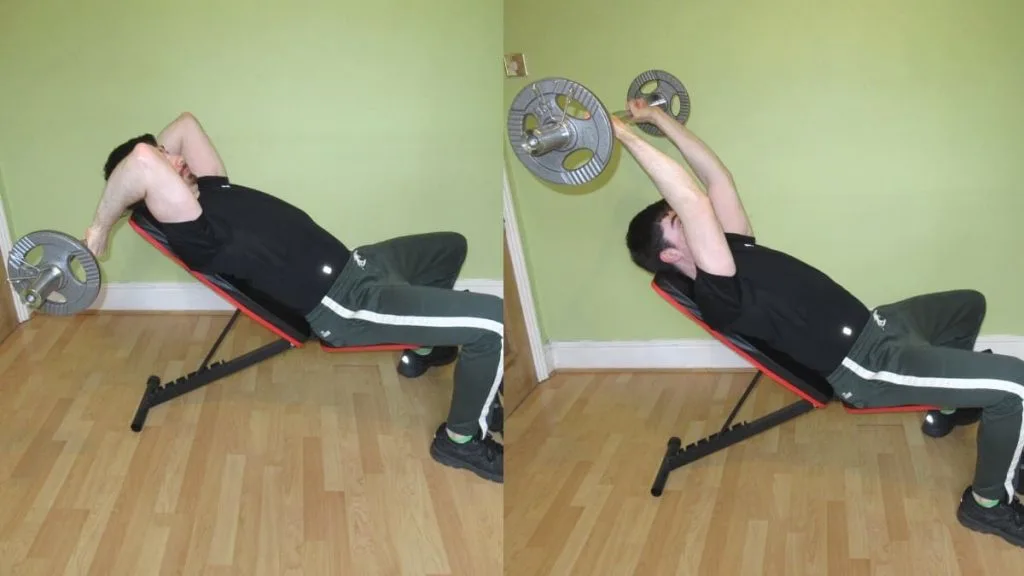
The incline French press is a hybrid of the standing French press and the lying French press. As such, it’s an ideal exercise for those who want to perform a traditional overhead French press but who lack the shoulder mobility to achieve proper overhead arm positioning in the standing version.
You want to use a bench angle of between 45 and 60 degrees so that it’s easy to get the bar into position.
Once you’re sat on the bench, pushing the bar up with your legs will help to propel it into a traditional incline pressing position. From there, you simply lower the bar behind your head and, depending on your shoulder mobility and the equipment you’re using, behind the bench as well.
Bringing the bar behind the bench will place the long head of your triceps under a greater eccentric stretch and prime your tris for hypertrophy as a result. Just make sure to avoid training to absolute failure—unless you have a spotter handy—so that you don’t get stuck with the bar behind the bench!
Cable French press
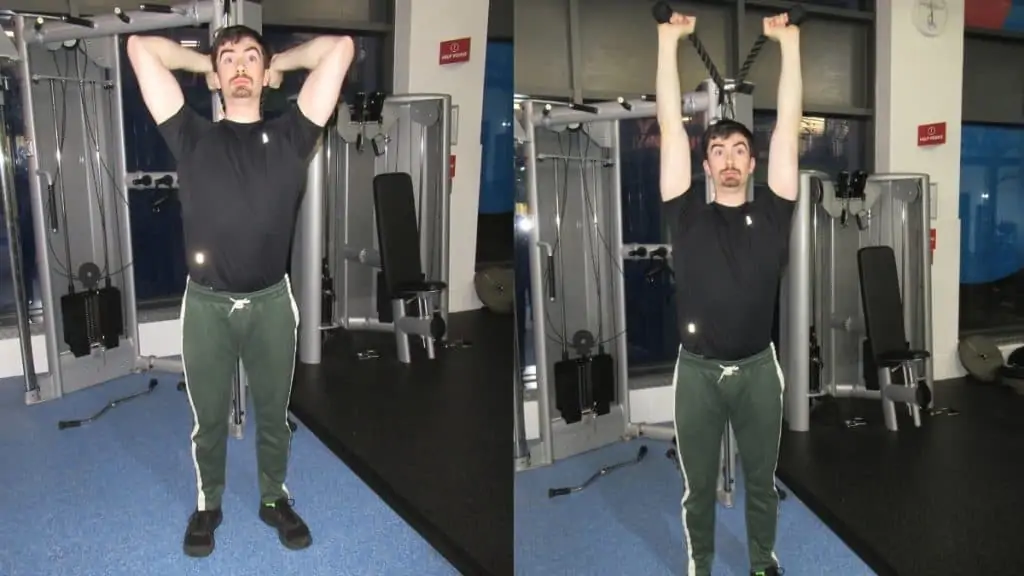
The cable French press taxes your triceps with constant tension so that your muscles have to contract harder and fight to complete every rep.
Even when your elbows are locked out, the cable system is still exerting some kind of force on your triceps because the pulley is always trying to pull you backward. This means that your triceps have to contract to resist the tension, which is one reason why cables create such a powerful muscle pump.
Since cable resistance is more consistent than that of free-weights, it’s typically also more joint-friendly because your triceps muscles are doing much more work than your elbow joints. This smooth cable resistance is especially beneficial given that the free-weight French press lift causes joint pain for some lifters.
Single arm French press
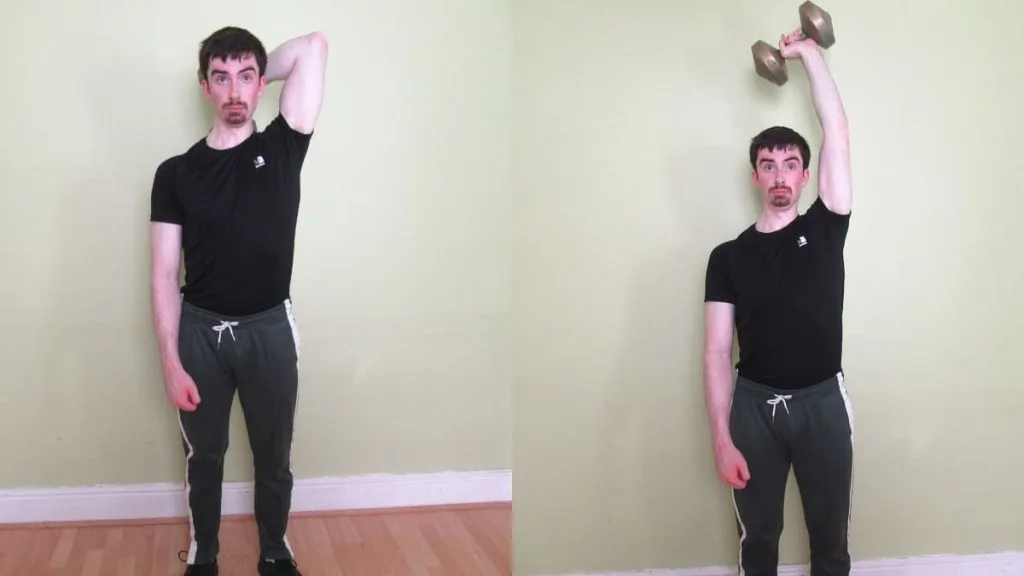
Since you have to lift each weight independently during a single arm French press, it’s an especially effective symmetry-sculpting exercise for those who have tricep muscular imbalances.
You can put significantly more effort into working each of your triceps when your brain doesn’t have to split its focus across two limbs.
This enhanced focus naturally enables you to establish a stronger triceps mind-muscle connection while ensuring (especially if you lift in front of a mirror) that your form is correct, which brings us nicely onto our next topic.
French press workout mistakes
Make sure to avoid these common French press workout mistakes if you want to maximize your triceps development while keeping your elbows safe.
Not controlling the weight
Failing to control the weight during the French press eccentric (which is to say as you lower the bar behind your head) robs your triceps of tension and skyrockets the amount of stress going through your elbows.
This error usually occurs when people lift excessively heavy weights and often coincides with using momentum to compensate for their triceps’ inability to lift the bar cleanly.
So rather than just letting the bar drop during the descent, make sure to control the weight with your triceps by lowering the bar over a 2-3 second period.
Controlling the weight will enhance the triceps stretch during the eccentric phase of the rep—thereby priming your triceps for growth—while simultaneously taking the stress off your elbows. In other words, using the proper French press form leads to a win-win scenario.
Performing half reps
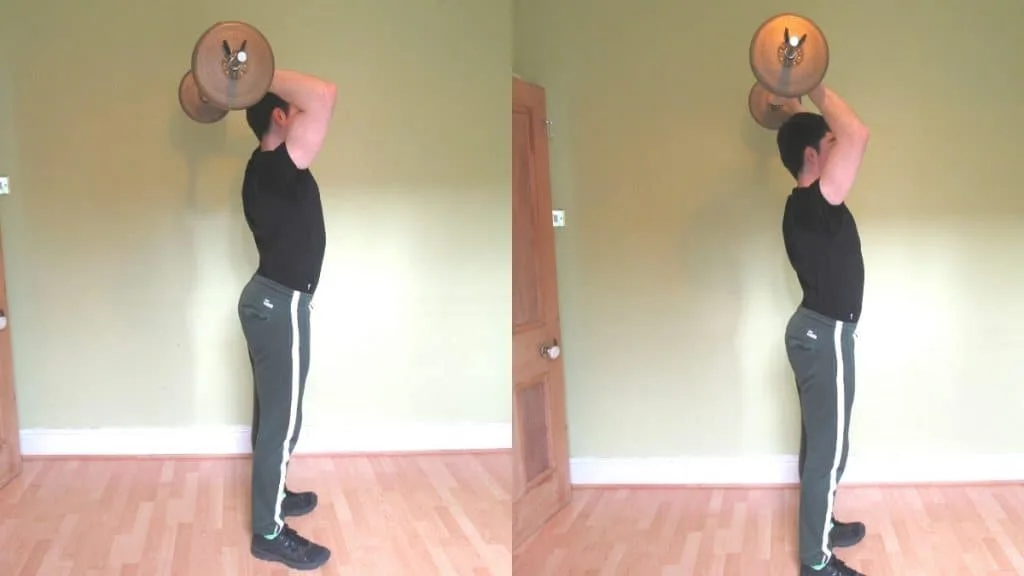
The reason that the French presses exercise gets results is that it places your triceps under a growth-stimulating eccentric stretch when the long head of the triceps is in its strongest force-producing position.
Yet, so many lifters fail to take advantage of the French press’ mass-building potential by performing partial reps.
Performing half reps goes hand in hand with lifting too much weight and drastically reduces the effectiveness of the French press by limiting the all-important eccentric triceps stretch.
So if you’re struggling to lift the weight over a full range of motion, lighten the resistance and focus on perfecting your form.
Make sure to lower the weight behind your head so that your triceps receive a deep stretch. Then, during the concentric phase of the rep, flex your triceps until your elbows are completely locked out.
Contrary to popular advice, you don’t want to avoid locking your elbows out because elbow extension (i.e., locking the elbows out) is the primary function of the triceps. [3] So go ahead and squeeze your triceps as your elbows reach full extension to make the most of the peak contraction.
Cheating the weight up
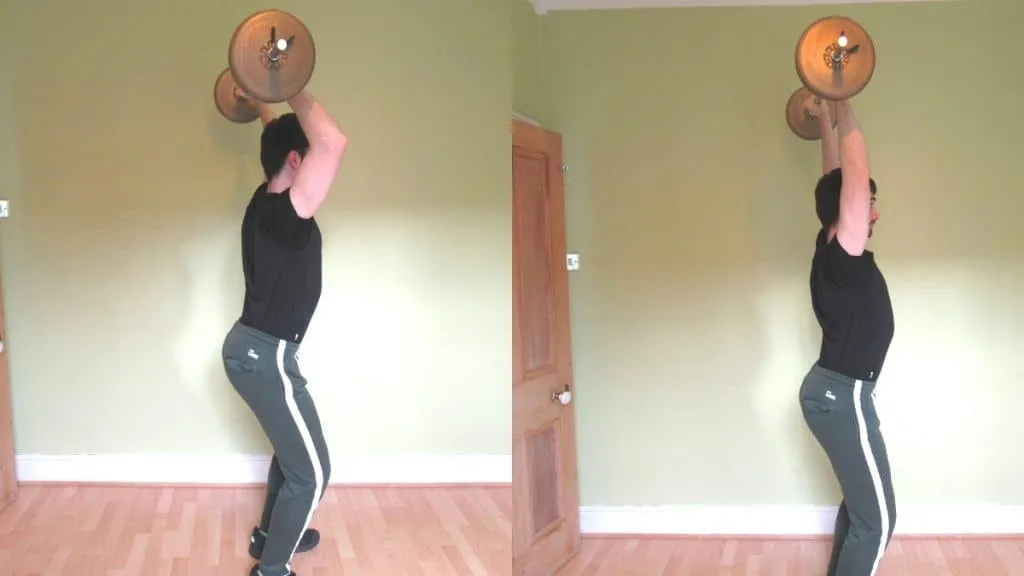
Using momentum to cheat the weight up is a common French press gym mistake that I see all the time—and it robs your triceps of growth.
While it’s true that bending your knees to fling the bar up enables you to lift more weight, the extra resistance isn’t directly benefiting your triceps. No, the extra tension (and perhaps even some of the regular working weight) is going to the muscles that you’re using to cheat, most likely your quadriceps and front delts.
So if anything, lifting heavier weights with the aid of momentum actually puts less tension on your triceps, which defeats the purpose of this isolation exercise.
Instead, keep your knees locked out and your hips extended so that you can’t use your legs for assistance.
Also, make sure to keep your elbows back so that you don’t involve your front delts dynamically by turning the French press into a weird tricep-extension-shoulder-press hybrid.
Flaring your elbows too much
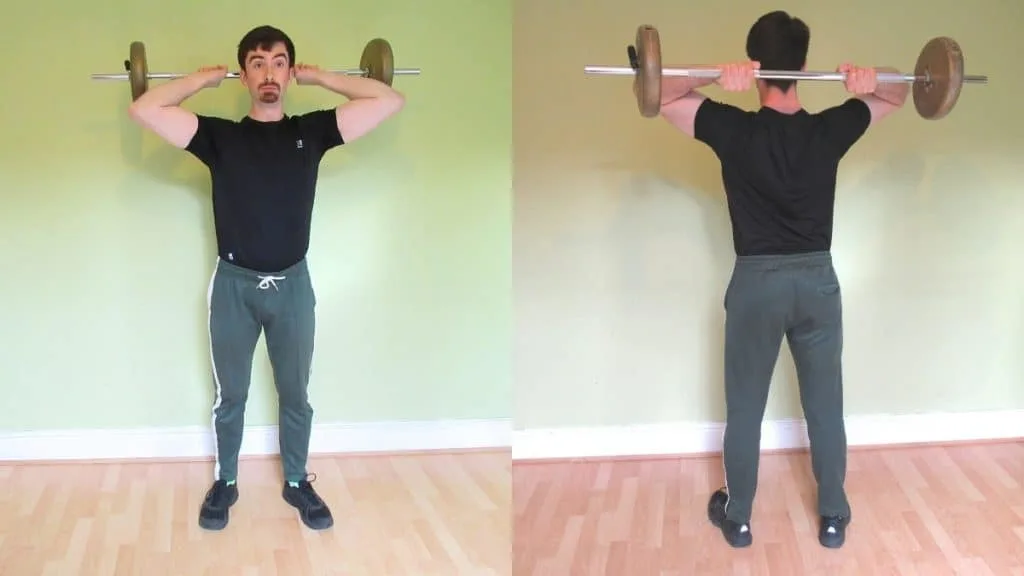
Some elbow flare during the French curls exercise is normal. However, you shouldn’t take it to the extreme.
If your elbows are pointing more out to the sides than they are facing forward, then you need to tuck your elbows closer to your temples.
Excessive elbow flare during tricep drills is known to cause joint pain and is one reason why exercises like the barbell French press get a bad rep even though they’re generally safe when performed correctly.
The degree of elbow flare depends on your grip, which in turn depends on your build and the hand position that you find most comfortable. So don’t panic if your elbow position isn’t identical to what you see in the pictures because there’s a large amount of individual variation when it comes to training technique.
Holding the bar incorrectly
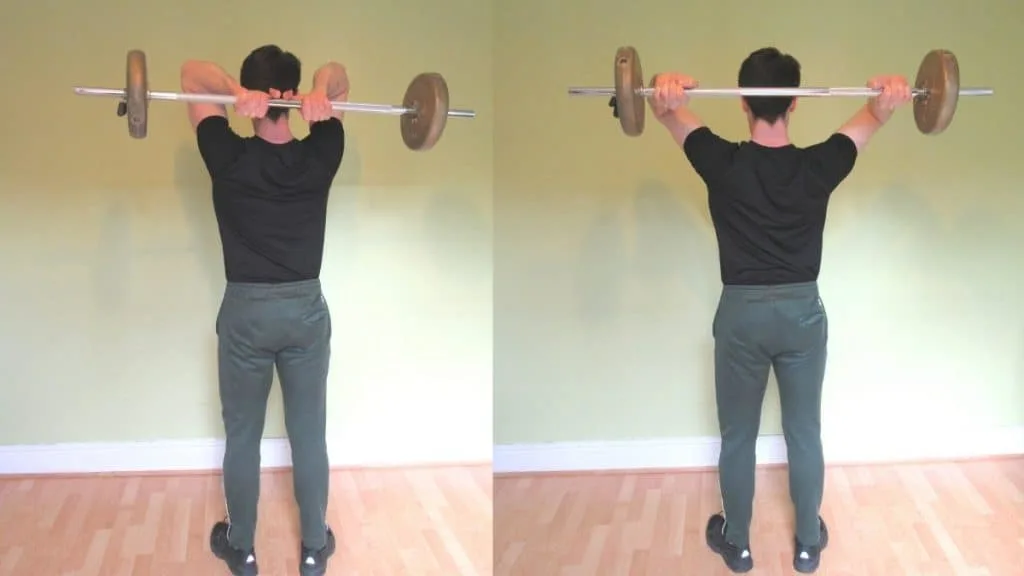
The French press lift produces the best results when you use the proper form. But one factor that many gym-goers fail to consider is their grip.
While the optimal grip for any exercise heavily depends on your build (people with a narrower build should generally use a closer grip), you also need to avoid extremes if you want to keep your joints safe and maintain the French press’ effectiveness.
Using an excessively close grip makes the bar more likely to become lopsided (which can lead to muscular imbalances) and puts a lot of pressure on your wrists. So while it’s okay to do a close grip French press if you find the exercise comfortable, you don’t want to grip the bar with your hands touching.
On the other hand, using an excessively wide grip will place more strain on your rotator cuffs and cause your elbows to flare out. So if you have a large build, by all means, perform a wide grip French press—just don’t grip the very ends of the bar.
Standing French press benefits
Learn how the French press weightlifting exercise strengthens your triceps and increases your pressing strength when you perform it consistently.
Thicker triceps
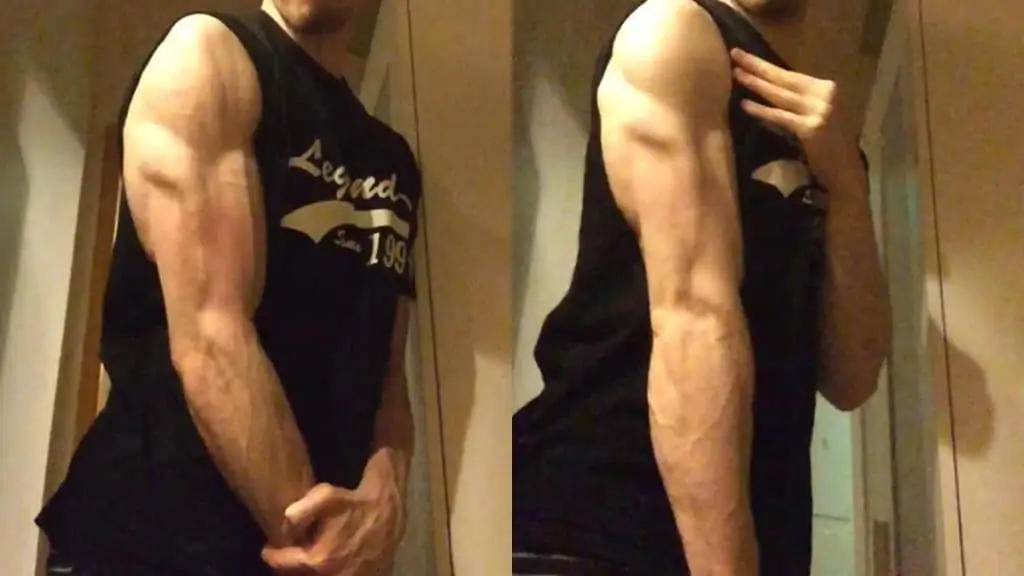
Because barbell french presses place your arms in an overhead position, they’re incredibly effective at training the long head of your triceps, which is the biggest tricep muscle by far.
Unlike the lateral and medial heads (which, even when combined, are still smaller than the long head), the long head performs shoulder extension as well as elbow extension. As such, when you put your shoulders into flexion by placing your arms over your head, the long head naturally receives an intense, growth-provoking stretch.
This deep eccentric stretch primes your triceps for hypertrophy by stimulating the fast-twitch muscle fibers with heavy mechanical tension. Eventually, this process of repeatedly stretching and contracting your triceps in their optimal force-producing position (when the muscle is lengthened) leads to the development of thicker upper arms and stronger triceps.
Stronger compound presses
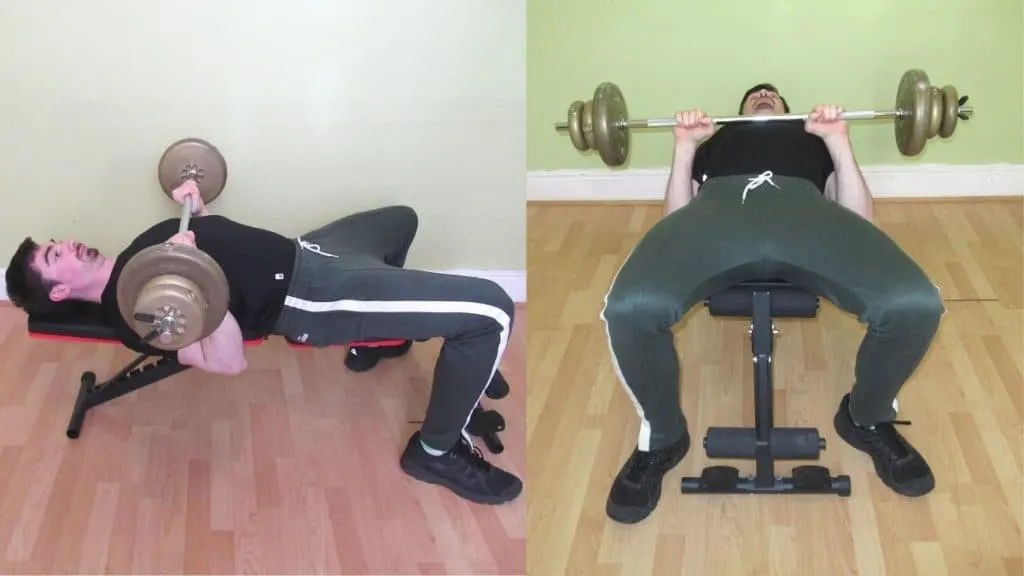
Besides making your t-shirt sleeves tighter, the tricep French press increases your compound pressing power by improving your lockout strength.
The lockout phase of a bench press and overhead press is handled mainly by the triceps due to the significant elbow extension involved in completing a heavy press rep.
Since the barbell French press is essentially like doing heavy lockouts with nothing but your triceps, the BB French press naturally has excellent carryover to your compound presses—especially when you use a full range of motion (no “constant tension” reps, please).
The lockout portion of the bench press is a weak point for many lifters. So given the fact that the French press makes your triceps bigger and thus more capable of producing force, it makes sense to do French presses in addition to your bench-specific training.
More core stability
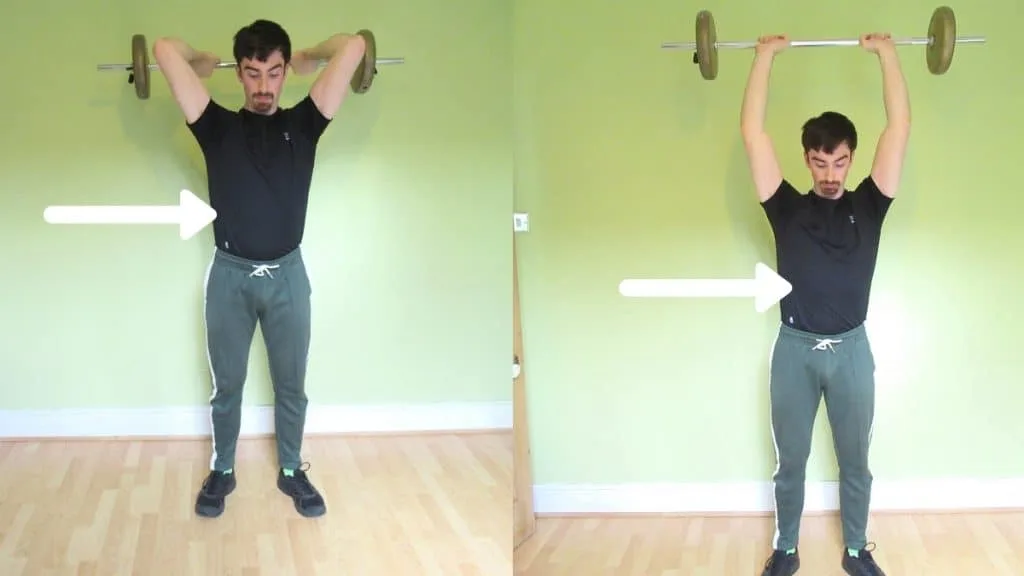
Performing a French press workout in a standing position is a surprisingly effective way to work your core. While your triceps have to lift the weight dynamically, it’s your abs that have to contract isometrically in order to keep your torso straight and stable.
Since your legs and core muscles are active when you do the French press standing up, you’ll also burn more calories than in the seated version. This extra energy expenditure can make it easier to lose body fat by helping you to get into an energy deficit. [4]
Overhead French press FAQ
Learn more about the French press tricep exercise with this in-depth FAQ.
What is a French press, and what muscles does it work?
A French press, also called a French curl, is a weight lifting exercise that strength trainees perform to work their triceps.
The French press is typically performed with a barbell, but a variety of other training tools like dumbbells and kettlebells can be used to achieve similar results.
The overhead French press trains the lateral, medial, and long head of the triceps and is thus popular among bodybuilders seeking to maximize their upper arm development.
Since the French press exercise puts your shoulders in a flexed position, it gives extra emphasis to the long head of the triceps because the long head is the only triceps muscle that’s capable of acting on the shoulder joint. Because the long head makes up the bulk of the triceps muscle, the French press is widely believed to be an effective exercise for maximizing triceps hypertrophy.
How many French press sets and reps should you perform?
The optimal number of French press sets and reps depends on your level of advancement, training goals, and recovery capabilities.
If you’re a novice lifter who’s not used to training their triceps with weights, perform 3-5 French press sets of 10-15 reps 1-2 times per week. If you’re doing the exercise once per week, perform more sets per session. If you’re doing it twice per week, then perform fewer sets per workout.
Intermediate lifters with good recovery capabilities should perform 3-5 sets of French presses twice per week. Do 10-15 reps on each set.
If you’re a highly experienced weight trainee with the triceps development to match, then you should also perform 3-5 sets of French presses twice per week.
However, because you’re more advanced, your program should contain more exercise variety. So even though you’re doing 6-10 sets of French press per week like the intermediate lifter, you’ll be lifting heavier weights and doing more total training volume.
Since doing the French Press lifting exercise with any kind of effort is quite elbow intensive, you should limit its performance to twice per week so that your joints and connective tissue structures have enough chance to recover.
Who should do the French press lift?
Anyone whose elbows are healthy and who wants to build their triceps can benefit from performing the French press lift on a weekly basis.
Although the standing French press is a popular exercise among bodybuilders seeking to add bulk to their arms, it can also be performed with lighter weights by those wishing to sculpt toned arms by limiting their triceps bulk.
Additionally, the French press is a valuable exercise for powerlifters and Olympic weightlifters who want to increase their elbow extension strength in order to help them lock out heavy barbells.
What’s the best way to do a French press?
The best way to do a French press for muscle growth is with a bar because barbells enable you to overload your triceps with more resistance than any other training tool.
For maximizing your muscle symmetry, however, dumbbells are the better choice because they allow you to work your triceps fairly equally (you might still have a better mind-muscle connection with one of your triceps).
What other French press exercises can you do?
In addition to the more common French press variations demonstrated above, you can add variety to your workout routine by giving some of these exercises a try.
- Deadstop French press
- Decline French press
- Kettlebell French press
- Kneeling French press
- Medicine ball French press
- Resistance band French press
- Stability ball French press
Conclusion: Should you do the barbell French press for your triceps?
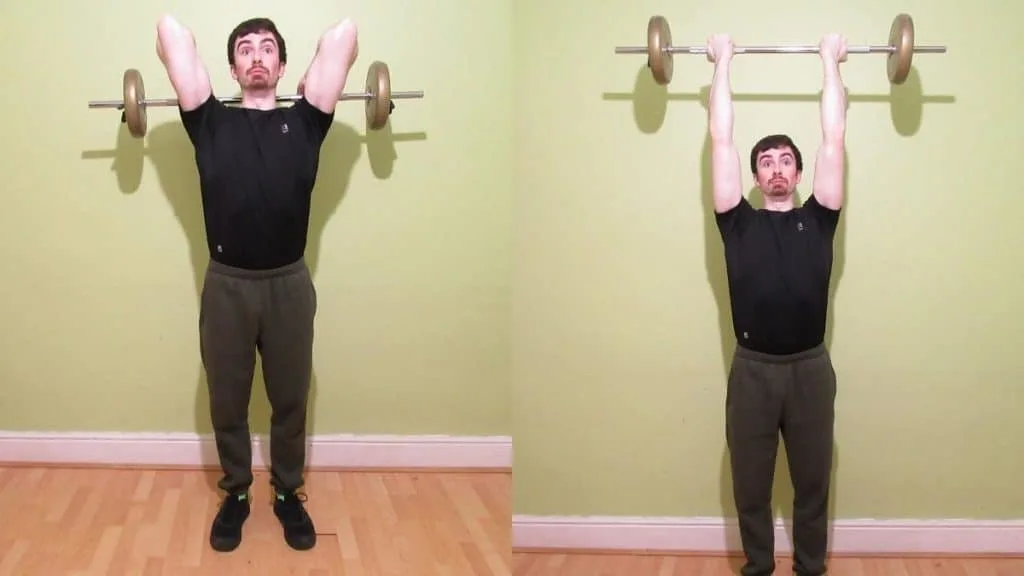
The heavy mechanical tension supplied by a correctly performed barbell French press places your triceps under an intense eccentric muscle stretch that primes them for hypertrophy.
As fast-twitch muscles, the triceps grow exceptionally well from explosive, low rep lifting.
However, because the French press is an isolation exercise, you shouldn’t sacrifice your form in order to lift more weight. Even though the triceps have a high proportion of type 2 muscle fibers, they’re still a relatively small muscle group and therefore can’t be trained with massive amounts of resistance during a single joint exercise.
So to get the most from the French press exercise, keep your elbows tucked in and focus on lifting the weight—over a full range of motion—purely with your triceps.
References
- Tomiyama, N., Islam, M. M., Rogers, M. E., Koizumi, D., & Takeshima, N. (2015). Effects of Seated vs. Standing Exercises on Strength and Balance in Community-Dwelling Older Women. Activities, Adaptation & Aging, 39(4), 280–290. https://doi.org/10.1080/01924788.2015.1089703
- Jung, M. C., & Hallbeck, M. S. (2000). Determination of Angles of Awkward Wrist Postures for Wrist and Grasp Force. Proceedings of the Human Factors and Ergonomics Society Annual Meeting, 44(29), 390. https://doi.org/10.1177/1541931200044029116
- Landin, D., Thompson, M., & Jackson, M. (2018). Functions of the Triceps Brachii in Humans: A Review. Journal of Clinical Medicine Research, 10(4), 290–293. https://doi.org/10.14740/jocmr3340w
- DiSalvo, D. (2018, February 26). How Many More Calories Does Standing Really Burn Over Sitting? Forbes. https://www.forbes.com/sites/daviddisalvo/2018/02/25/how-many-more-calories-does-standing-really-burn-over-sitting/?sh=2c7755796d3d

